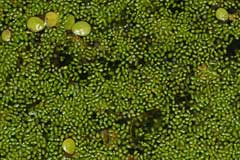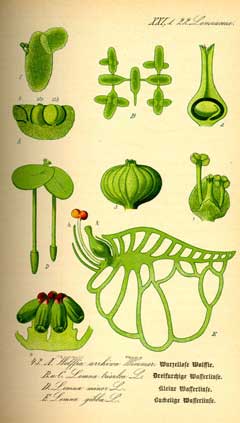 |
|
commons.wikimedia.org/wiki/User:Fice |
 |
| commons.wikimedia.org/wiki/File:Illustration_Wolffia_arrhiza0.jpg |
Translate this page:
Summary
Physical Characteristics
![]()
![]() Wolffia arrhiza is an evergreen Perennial.
Wolffia arrhiza is an evergreen Perennial.
See above for USDA hardiness. It is hardy to UK zone 7. It is in leaf all year, in flower all year, and the seeds ripen all year. The species is hermaphrodite (has both male and female organs).
Suitable for: light (sandy), medium (loamy) and heavy (clay) soils. Suitable pH: neutral and basic (mildly alkaline) soils and can grow in very alkaline soils.
It cannot grow in the shade. It can grow in water.
UK Hardiness Map
US Hardiness Map
Synonyms
Plant Habitats
Pond;
Edible Uses
Edible Parts: Leaves
Edible Uses:
Leaves - cooked. An excellent flavour, they taste somewhat like a sweet cabbage[183]. The leaves are very nutritious, containing about 20% protein, 44% carbohydrate. 5% fat and are rich in vitamins A, B2, B6, C and nicotinic acid[183].
References More on Edible Uses
Medicinal Uses
Plants For A Future can not take any responsibility for any adverse effects from the use of plants. Always seek advice from a professional before using a plant medicinally.
None known
References More on Medicinal Uses
The Bookshop: Edible Plant Books
Our Latest books on Perennial Plants For Food Forests and Permaculture Gardens in paperback or digital formats.

Edible Tropical Plants
Food Forest Plants for Hotter Conditions: 250+ Plants For Tropical Food Forests & Permaculture Gardens.
More

Edible Temperate Plants
Plants for Your Food Forest: 500 Plants for Temperate Food Forests & Permaculture Gardens.
More

More Books
PFAF have eight books available in paperback and digital formats. Browse the shop for more information.
Shop Now
Other Uses
References More on Other Uses
Cultivation details
A pond plant, floating on the surface of the water, it requires a sunny position in still water that is rich in nitrates and lime[200]. At the limit of its climatic range in Britain and probably best grown in a cold water aquarium[200]. It over-winters in temperate areas by means of resting buds which sink to the bottom of the pond in the late autumn and rise again in the spring[200]. One of the smallest flowering plants in the world, it is cultivated as a vegetable in Burma, Laos and Thailand[183]. It has been recommended for commercial cultivation, especially in tropical areas, because of its rapid multiplication and high nutritional value[183]. Plant densities of over two million plants per square metre have been found[274].
References Carbon Farming Information and Carbon Sequestration Information
Temperature Converter
Type a value in the Celsius field to convert the value to Fahrenheit:
Fahrenheit:
The PFAF Bookshop
Plants For A Future have a number of books available in paperback and digital form. Book titles include Edible Plants, Edible Perennials, Edible Trees,Edible Shrubs, Woodland Gardening, and Temperate Food Forest Plants. Our new book is Food Forest Plants For Hotter Conditions (Tropical and Sub-Tropical).
Shop Now
Plant Propagation
Seed - we have no information on this species but, since it can spread rapidly by division, it really needs no extra help once it is in a pond.
Other Names
If available other names are mentioned here
Native Range
TEMPERATE ASIA: Iran, Israel, Georgia TROPICAL ASIA: India (Jammu and Kashmir) SOUTHERN AMERICA: Brazil (Rio de Janeiro) EUROPE: United Kingdom, Austria, Belgium, Germany, Hungary, Netherlands, Poland, Belarus, Russian Federation (Volgogradskaja oblast), Ukraine, Bulgaria, Croatia, Italy (incl. Sicily), Romania, Serbia, Slovenia, Spain, France, Portugal AFRICA: Algeria, Morocco, Kenya, Tanzania, Uganda, Burundi, Rwanda, Côte D‘Ivoire, Ghana, Nigeria, Senegal, Togo, Angola, Mozambique, Botswana, South Africa (Cape Province, KwaZulu-Natal, Transvaal), Madagascar
Weed Potential
Right plant wrong place. We are currently updating this section.
Please note that a plant may be invasive in one area but may not in your area so it's worth checking.
Conservation Status
IUCN Red List of Threatened Plants Status :

Growth: S = slow M = medium F = fast. Soil: L = light (sandy) M = medium H = heavy (clay). pH: A = acid N = neutral B = basic (alkaline). Shade: F = full shade S = semi-shade N = no shade. Moisture: D = dry M = Moist We = wet Wa = water.
Now available:
Food Forest Plants for Mediterranean Conditions
350+ Perennial Plants For Mediterranean and Drier Food Forests and Permaculture Gardens.
[Paperback and eBook]
This is the third in Plants For A Future's series of plant guides for food forests tailored to
specific climate zones. Following volumes on temperate and tropical ecosystems, this book focuses
on species suited to Mediterranean conditions—regions with hot, dry summers and cool, wet winters,
often facing the added challenge of climate change.
Read More
Expert comment
Author
(L.)Horkel. ex Wimm.
Botanical References
17200204
Links / References
For a list of references used on this page please go here
Readers comment